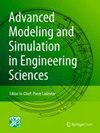金属增材制造过程局部热建模中常见简化方法的分类与分析
IF 3.2
Q3 MECHANICS
Advanced Modeling and Simulation in Engineering Sciences
Pub Date : 2023-11-08
DOI:10.1186/s40323-023-00253-z
引用次数: 0
摘要
近年来,金属增材制造的计算过程建模受到了广泛的关注。许多过程模型的基础是增材制造过程中的瞬态热响应。由于AM中热条件的沉积尺度建模在计算上是昂贵的,因此空间和时间简化,例如模拟整个层或多层的沉积,以及延长激光曝光时间,在文献中通常采用。虽然有利于降低计算成本,但这些简化对温度历史准确性的影响是逐案报告的。在本文中,现有文献中的简化首先在一个标准化的简化空间中进行分类,该简化空间基于空间和时间域的假设。随后,通过数值算例对各种简化形式进行了研究,并与高保真参考模型进行了比较。建立了每个简化所需的数值离散化,导致计算时间的公平比较。在建立热AM模型时,对捕获热历史的不同建模简化的适用性的整体方法为简化的适用性提供了指导。本文章由计算机程序翻译,如有差异,请以英文原文为准。
Classification and analysis of common simplifications in part-scale thermal modelling of metal additive manufacturing processes
Abstract Computational process modelling of metal additive manufacturing has gained significant research attention in recent past. The cornerstone of many process models is the transient thermal response during the AM process. Since deposition-scale modelling of the thermal conditions in AM is computationally expensive, spatial and temporal simplifications, such as simulating deposition of an entire layer or multiple layers, and extending the laser exposure times, are commonly employed in the literature. Although beneficial in reducing computational costs, the influence of these simplifications on the accuracy of temperature history is reported on a case-by-case basis. In this paper, the simplifications from the existing literature are first classified in a normalised simplification space based on assumptions made in spatial and temporal domains. Subsequently, all types of simplifications are investigated with numerical examples and compared with a high-fidelity reference model. The required numerical discretisation for each simplification is established, leading to a fair comparison of computational times. The holistic approach to the suitability of different modelling simplifications for capturing thermal history provides guidelines for the suitability of simplifications while setting up a thermal AM model.
求助全文
通过发布文献求助,成功后即可免费获取论文全文。
去求助
来源期刊

Advanced Modeling and Simulation in Engineering Sciences
Engineering-Engineering (miscellaneous)
CiteScore
6.80
自引率
0.00%
发文量
22
审稿时长
30 weeks
期刊介绍:
The research topics addressed by Advanced Modeling and Simulation in Engineering Sciences (AMSES) cover the vast domain of the advanced modeling and simulation of materials, processes and structures governed by the laws of mechanics. The emphasis is on advanced and innovative modeling approaches and numerical strategies. The main objective is to describe the actual physics of large mechanical systems with complicated geometries as accurately as possible using complex, highly nonlinear and coupled multiphysics and multiscale models, and then to carry out simulations with these complex models as rapidly as possible. In other words, this research revolves around efficient numerical modeling along with model verification and validation. Therefore, the corresponding papers deal with advanced modeling and simulation, efficient optimization, inverse analysis, data-driven computation and simulation-based control. These challenging issues require multidisciplinary efforts – particularly in modeling, numerical analysis and computer science – which are treated in this journal.
 求助内容:
求助内容: 应助结果提醒方式:
应助结果提醒方式:


